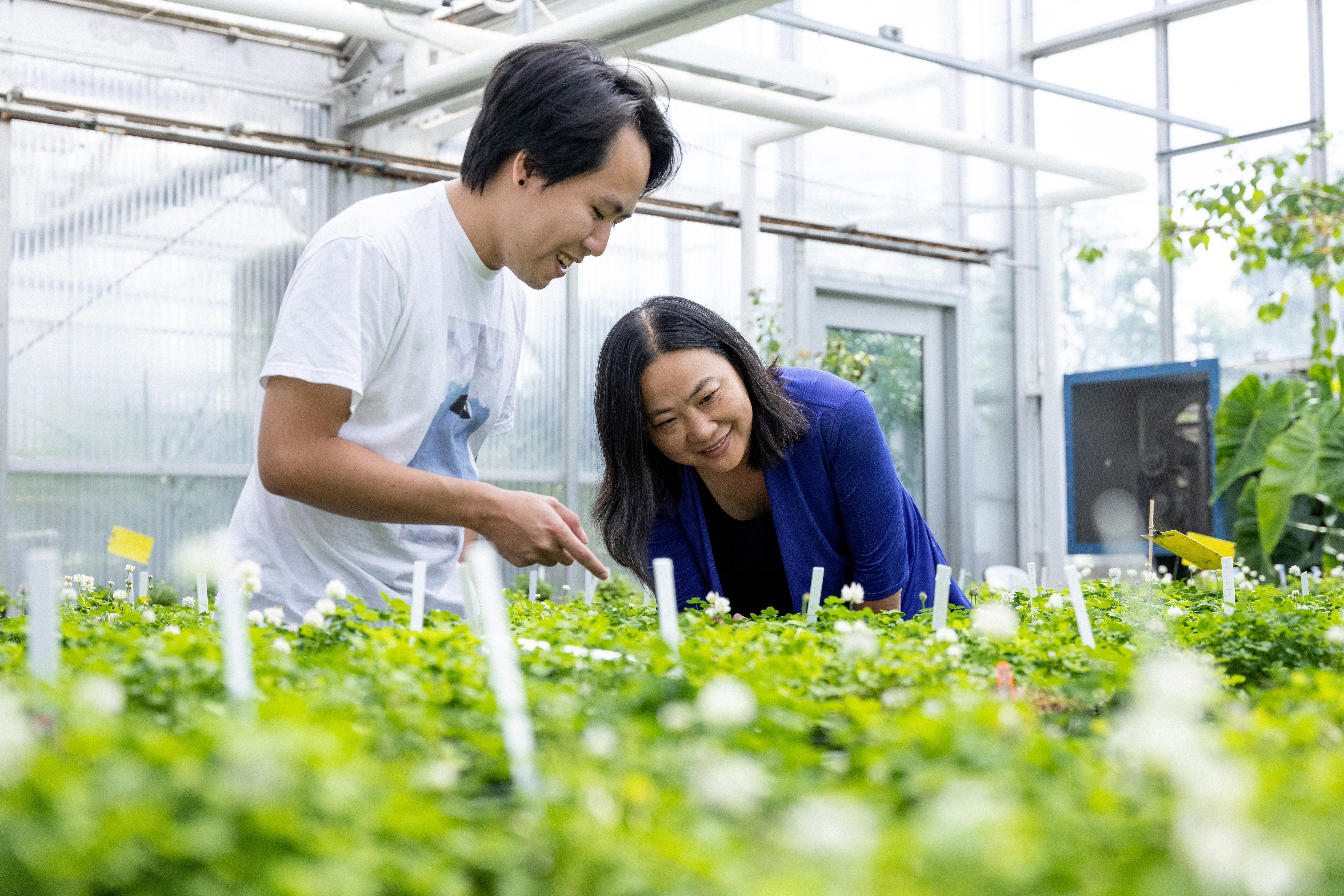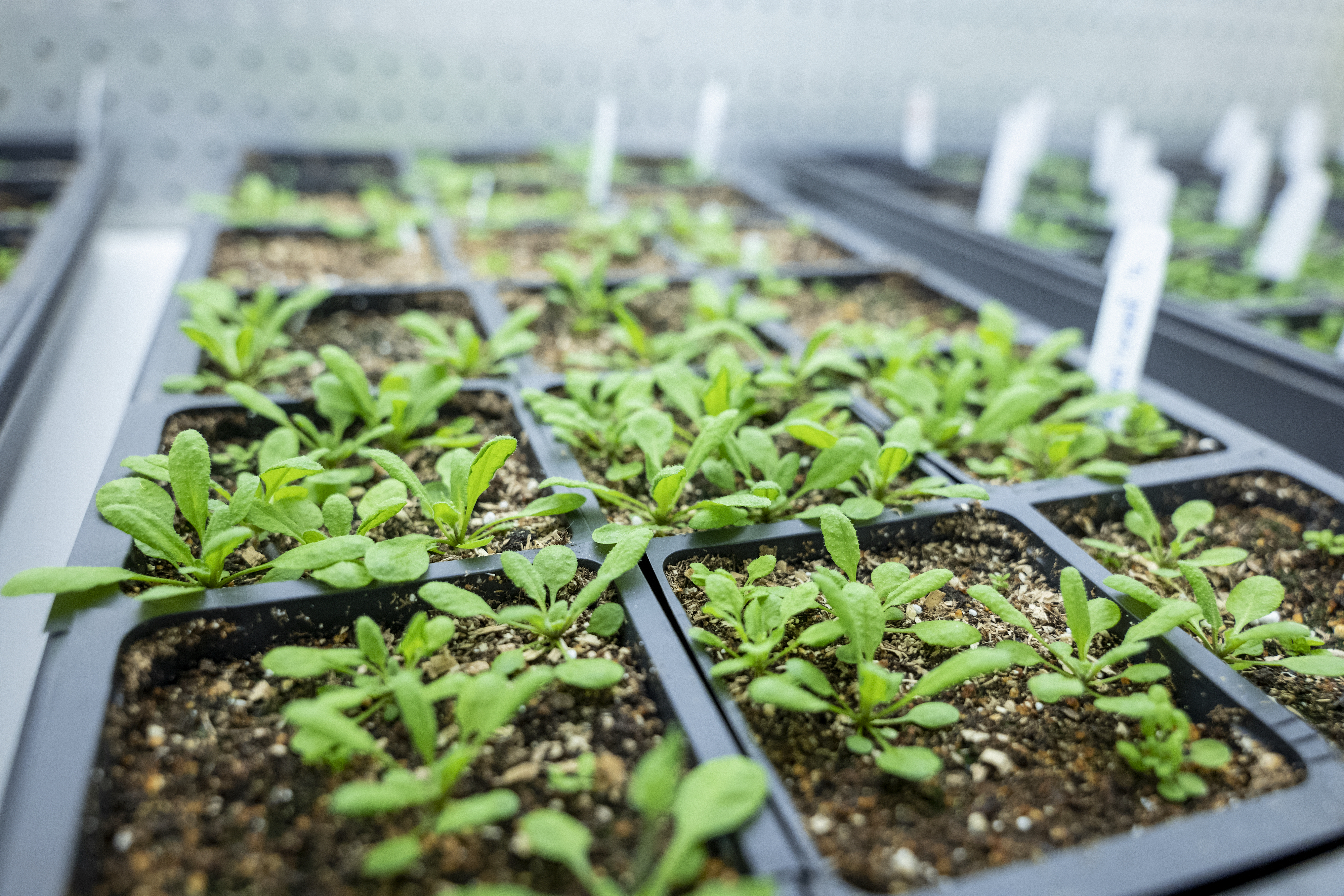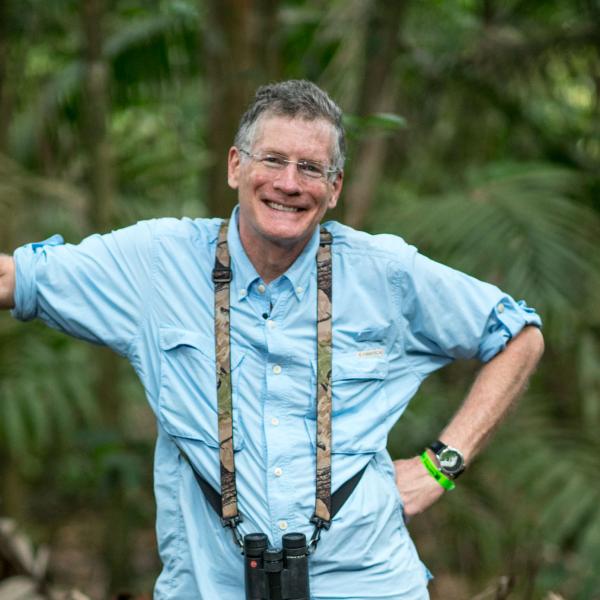Step behind the bench with four scientists whose evergreen passion for plants could fuel life-changing discoveries that extend far beyond the greenhouse.
Some science labs gleam with sterilized countertops and freshly washed beakers. But walk into the laboratory of Xuehua Zhong, professor of biology, and you’re immediately immersed in green.
Zhong and her group raise a perpetual bumper crop of Arabidopsis thaliana, a delicate weedy plant commonly called thale cress. The ten thousand or more individual plants in her collection — including many in the Jeanette Goldfarb Plant Growth Facility — grow in precisely controlled conditions that replicate real-world challenges including drought and excess heat.
Zhong may have the greenest lab on campus, but she’s far from the only researcher working to understand the inner secrets of plants. “That’s why I came here,” she said. “The university has amazing resources, and there’s a community of plant scientists doing exciting things.” While dozens of standout Arts & Sciences researchers, from professors to graduate students, focus on plants, four took a short break from the lab to talk about their work, insights, and favorite leafy subjects.
A plant-powered approach to climate change
Joe Jez, the Spencer T. Olin Professor in Biology, embodies the department’s preoccupation with plants. He started his career as a biochemist with a plan to eventually get into pharmaceuticals, but over the years his work has become overrun with members of the plant kingdom.
“Plants are nature’s original do-it-yourselfers,” he said. “Think about when a seed lands somewhere. It has to figure out how to grow roots; it has to figure out how to get sunlight. There’s just incredible chemistry within a plant.”

Jez’s lab uses X-ray crystallography and other methods to study the fundamental structures of plants.
His research has led to some surprising and potentially significant findings. In 2022, Jez co-authored a Science Advances paper describing a mutation in thale cress — the same species growing in Zhong’s laboratory — that increased the plant’s uptake of carbon dioxide (CO2) by 30%. While other researchers mapped out the genetic differences between plants, Jez used his expertise to identify the physical changes that turned the plants into carbon-gobbling machines.
If the same mutation that cranked up the carbon in cress could be introduced in other, more substantial crops like corn or soybeans, the impact could ripple across the planet, Jez said. “You could pull more CO2 out of the environment and maybe get bigger, more nutrient-enriched plants. That could have implications for our ability to remove carbon from the environment and ultimately slow climate change.”
In another study published in the Proceedings of the National Academy of Sciences in 2022, Jez and co-authors described how thale cress controls the balance of auxin, a plant hormone that regulates growth. They found that plants use a complicated series of inhibitors to keep hormone levels in balance. Auxin was discovered decades ago, but the nuances of its ebb and flow in a plant had been largely unknown. “We already have roadmaps for the biochemistry of plants, but there’s a lot about metabolism that we still don’t understand,” Jez said. The finding, he said, is another example of an insight that could potentially be used to ramp up plant growth, which in turn could remove more CO2 from the atmosphere.
Jez’s ability to visualize the smallest components of cells has led to some surprising projects beyond the plant world. In a 2022 paper co-authored with, among others, Nupam Mahajan, professor of surgery at WashU’s School of Medicine, Jez and colleagues shared findings that could one day help researchers find new treatments for prostate cancer. Other scientists on the team had noted a genetic quirk in prostate cancer cells, but they needed help understanding the structures of the proteins involved. Before long, the cancer researchers had enlisted a plant specialist to join the team. “Collaboration is like a pick-up basketball game,” Jez said. “It keeps things interesting.”
"We’re answering burning questions that are relevant to human health as well as plants."
The evolution of rice
Kenneth Olsen, the George William and Irene Koechig Freiberg Professor of Biology, frequently works with international colleagues to study the evolution and genetics of plants. Much of his focus is on rice, a crop that has been grown under human control for 10,000 years. Olsen explained that domesticated crops are like prolonged experiments in natural selection. Twenty years ago, rice became the first plant to have its entire genome decoded. “That opened up a world of possibilities for studying the connection between genes and traits,” Olsen said.

In a 2023 study published in BMC Biology, Olsen and a team of researchers from China and the Philippines examined the genomes of 13 varieties of wild and domesticated rice to identify genes that were lost during domestication. In many cases, they were able to connect the genetic change to a specific trait. For example, in japonica rice, the most common variety grown in East Asia, the deletion of the gene Os03g27510 improved grain length.
Understanding the genetic basis of specific traits could help boost crop production through selective breeding or genetic engineering, Olsen said. Rice is a crucial component of global food supply, so any insight into its growth and cultivation could have significant repercussions. “I’m a basic research scientist, but I definitely recognize and value the potential impacts that our research could have on crop improvement,” he said.
Olsen and his team are also working to understand “weedy” rice, a feral form of the crop that has become a scourge to rice farmers in the United States and other parts of the globe. Marshall Wedger, a postdoctoral researcher in Olsen’s lab, has visited rice fields in Arkansas to inspect them and talk with farmers about this aggressive weed. “Farmers can lose up to 80% of their harvest to weedy rice,” Olsen explained. The farmers, he said, are eager to share their observations and get help. “It can be so incredibly valuable to interact with farmers and get the insights of people who really understand the biology of a given species in its natural environment,” he said.
In 2022, Olsen, Wedger, and Nilda Roma-Burgos, a professor of weed physiology and molecular biology at the University of Arkansas, published a study that explored the genomes of weedy rice samples collected from five Arkansas rice fields. They found that most plants are actually hybrids of domestic crops and weedy ancestors, a radical shift from just 20 years ago, when hybrids were rare. The researchers speculated that the widespread use of herbicides over the last two decades has created a new generation of hybrid weeds that are relatively resistant to chemicals. “It’s incredibly easy for these weeds to adapt and evolve,” Olsen said. The findings, he added, underscored the dangers of using just one method — in this case, a single type of herbicide — to control weeds.
Science in the parks

Weeds are also on the mind of Rachel Penczykowski, assistant professor of biology. Penczykowski studies the interplay between plants and their pathogens, including a fungus known as powdery mildew. The fungus is a major headache for farmers growing melons, lettuce, tomatoes, beans, and many other crops. “Lots of different fungal pathogens affect plants that we care about,” she said. Powdery mildews also infest common weeds in the St. Louis area, which makes it easy to study the fungal pest close to home.
In January, Penczykowski received a prestigious CAREER award from the National Science Foundation to support her investigations of powdery mildew on broadleaf weeds in and around the city. The award is reserved for junior faculty who excel at mentoring while successfully integrating research and education. Penczykowski involves undergraduates and even local high school students in her studies of weeds and mildews in various environments, from downtown St. Louis parks to the Shaw Nature Reserve in Gray Summit.
Penczykowski wants to know how variations in shade, heat, and other factors affect infestations. Previous work has shown that the fungus seems to do especially well in more urban environments. She speculates that the large amount of foot traffic through parks might help disperse fungus spores. But it’s also possible that the fungus thrives in the warmth generated by city living. “We know that there’s a lot of heat produced by industry and vehicles,” she said. As the climate warms, there’s a risk that mildews and other fungi will thrive even more.

Epigenetic control
Back in Zhong’s lab, graduate students adjust heat lamps and add precise amounts of water to trays of thale cress. The work is part of her larger mission to study the evolutionary strategies that plants use to thrive and survive. “We are looking at how plants respond to an ever-changing environment,” she said. The cress have an eight-week lifecycle, making it possible for Zhong and her team to track multiple generations.
The team focuses on epigenetics, a molecular process that controls the expression of genes without altering DNA. In 2022, Zhong co-authored a paper with colleagues at the University of Wisconsin-Madison and the University of California, Riverside, that explained how enzymes attached to DNA in thale cress switch specific genes off and on. “That study addressed a long-standing unanswered question in the field,” she said. “We knew that epigenetic control is very stable and is transmitted from one generation to the next, but we didn’t know why it always happened in the same parts of the genome.”
Epigenetics is also a crucial process for human health, including the normal division of cells, so the findings in Zhong’s lab have implications far beyond the greenhouse. “We’re answering burning questions that are relevant to human health as well as plants,” she said. Zhong’s findings in cress have informed ongoing research into leukemia, a disease that can begin when normal epigenetic processes break down. In 2022, she received a five-year, $2.1 million Maximizing Investigators’ Research Award from the U.S. National Institutes of Health (NIH), a grant that continued the institute’s long-standing support of her research.
The NIH award is another reminder that plant science is ultimately about far more than the individual grasses, trees, or shrubs. “Climate change, crop improvement, sustainable agriculture, human health…we have the tools, the people, and the resources to go in all of those directions,” Zhong said. “This is very unique to WashU.”
A rich environment for plant research
Plant researchers at WashU are part of a powerful research ecosystem that stretches across St. Louis. On the Danforth Campus, the three-story Jeanette Goldfarb Plant Growth Facility provides just about any type of growing environment a scientist needs, from desert to tropical.

WashU also maintains close research ties with the Missouri Botanical Garden, a 79-acre expanse of trees, flowers, and shrubs in St. Louis. “The botanical garden gives us access to a huge collection of plants and a number of people with specific expertise,” said Barbara Schaal, the Mary-Dell Chilton Distinguished Professor.
That partnership grew deeper in 2018 with the launch of the Living Earth Collaborative, a joint project of the botanical garden, WashU, and the Saint Louis Zoo that aims to promote conservation and biodiversity of plants and animals.
WashU also enjoys a symbiotic relationship with the Donald Danforth Plant Science Center, a St. Louis-based research institute that supports more than 400 scientists from around the world.
That combination — WashU, the Missouri Botanical Garden, and the Danforth Center — adds up to a plant research consortium that stands out on the global stage, said Schaal, a renowned expert in plant evolution. "When you bring those institutions together, their strengths are amplified," Schaal said.






